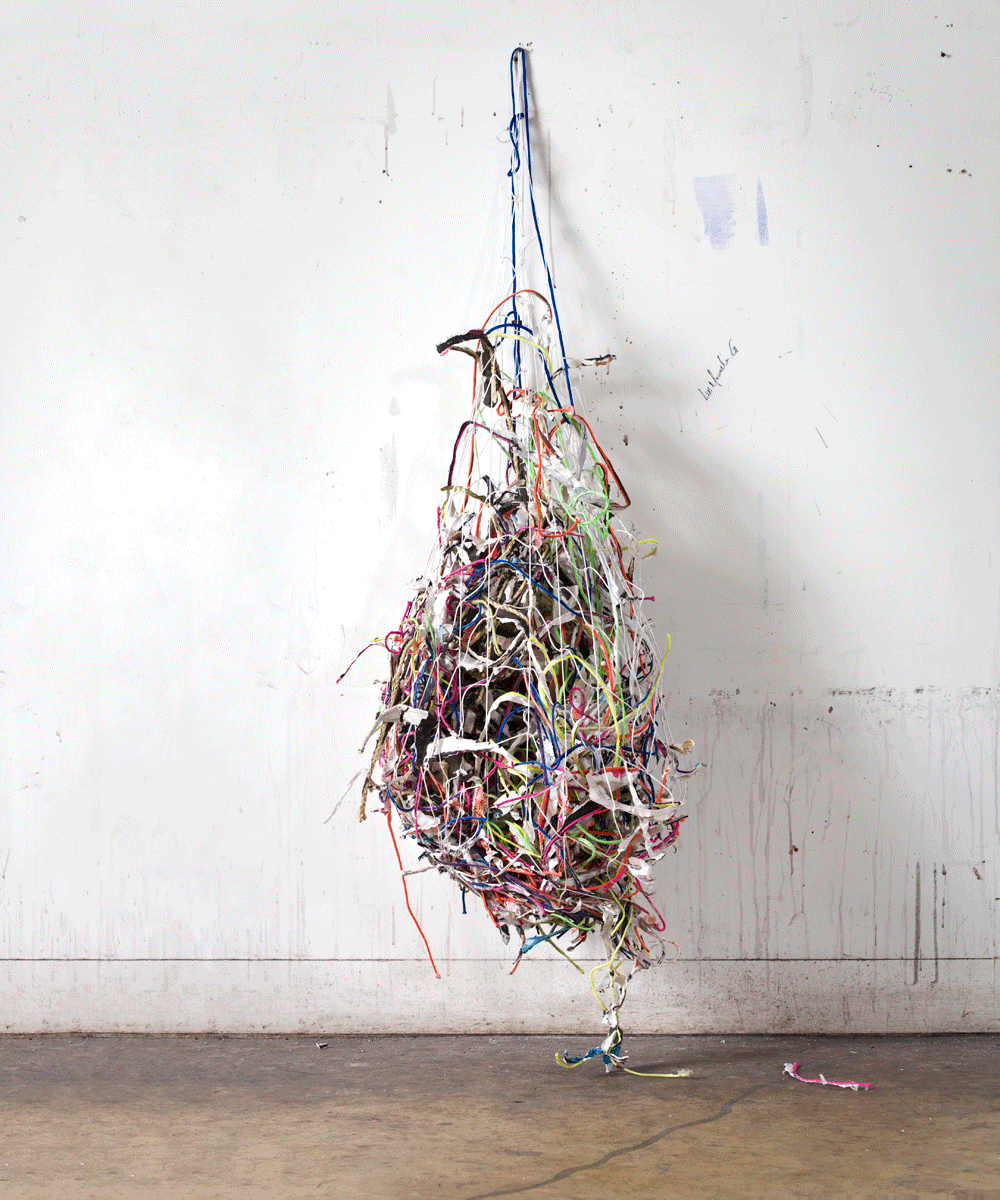Mark Bradford
Wexner Center for the Arts, Columbus, Ohio, USA
Wexner Center for the Arts, Columbus, Ohio, USA

This is a show about painting: its glorious squirts, its crusted residues, its gossamer shimmer. Ironically, though, there’s very little traditional oil or acrylic involved here. Rather, Mark Bradford hijacks and repurposes a range of socially freighted tools and materials, fashioning fields of found signs into papery archaeologies of the city. He paints with bleach, draws with coloured cord, singes paper and revels in the unruly squelches of the caulk gun. He then abrades and pits his beleaguered surface – usually local billboards peddling paternity tests or new credit – with an electric sander. Clearly a regular at the hardware store, Bradford’s processes are muscular, his materials manifestly physical, yet the resulting paintings couple brutalism with grace.
As curator Christopher Bedford is acutely aware, Bradford’s practice hinges on its varying economies of scale: the gargantuan leap between the titanic heft of the paintings and their Lilliputian components activate rhythms both syncopated and jumpy. The installation at the Wexner Center for the Arts nods to the alternating tempo of these works, punctuating the massive with the minor, the labyrinthine with the austere, and weaving a fluctuating passage through a decade of the artist’s work. By exposing the disparate, often irreconcilable, strands of Bradford’s practice, the exhibition explodes open his oeuvre, revealing a virtuosic but restless artist.
Eschewing a chronological organization in the Wexner’s nave-like space, Bedford’s installation re-enacts the spiraling movement of the artist’s own recursive practice, as Bradford revisits and ‘re-finds’ his own discarded materials, compositions and palettes. So the muted greys and browns of early works such as Smokey (2003) call across a small gallery to the recent staccato striations of Grey Gardens (2010), one of Bradford’s many filmic titles. (This one alludes to Albert and David Maysles’ eponymous 1975 documentary.) NTSC and PAL (both 2010), also nearly achromatic, hang nearby. Distressed silvery fields constructed from custom-made graphite paper – charcoal rectangles of newsprint edged with cream borders – these works tether together Bradford’s longtime interests in cinematic technology, painterly abstraction and bravura displays of process. Although fabricated from layers of graphite paper gnawed by the sander, NTSC and PAL read like marbled paper, as though they were produced by liquid pigments stirred together. In this way, even as the final image ‘delivered’ to us a static and desiccated blank, NTSC’s evocation of swirling movement nods to the flows of cinematic motion. At the same time, the work’s painterly eddies quote from Bradford’s own inventory of processes: his distinctive procedure of soaking his billboard papers in vats of coloured water.
If Bradford’s gentle, aqueous coaxing apart of paper is one trick from his sundry bag of techniques and materials, so too is Hannibal (2005–10), a stack of the artist’s signature raw material of billboards, and Bag of Tricks (2009), a mesh sack of the snaking multicoloured cords he embeds in his surfaces. Like another suggestively titled work, Method Man (2004), these distilled meditations on process are proffered as pauses in the daily routine of painting which acknowledge the weight – social, political, economic – of individual materials. In the next gallery, video is also pressed into the service of documenting Bradford’s scavenging modus operandi: Across Canal (2009–10) chronicles his process of constructing Mithra (2008), the colossal ark he built from rescued shipping containers and billboards in New Orleans’ Ninth Ward. Yet if the salvaging of culturally embedded objects remains the work’s structuring principle, the deeply politicized American landscape forms the cognitive ground upon which Bradford’s painterly investment in materials unfolds. Racist cartographies ripple through the silvery shimmer of Mississippi Gottdam (2007), while the blood-red ground of Scorched Earth (2006) conjures harrowing visions of militarism and its destructive conflagrations.
Throughout the exhibition, Bradford’s project emerges as both socially rooted (in economies of race and gender) and as a series of painterly gambits that push abstract painting into new territories. The catalogue essayists productively plumb this tension, nudging Bradford’s practice away from rehearsals of his roots in the street and hair salon and towards more fecund lineages of abstract painting (Robert Storr), ‘materialist realism’ (Richard Shiff) and the poetics of legibility (Katy Siegel). Hilton Als ruffles art history-as-usual with a fabulous fictive interlude essential for grasping Bradford’s most recent project, Pinocchio is On Fire (2010). A multi-part enterprise that comprises album covers as well as a radio broadcast (see pinocchioisonfire.org), the corporeality implicit in so much of Bradford’s work becomes palpable in this walk-in installation. Engaging graphite paper in the serial mode of his end papers, Bradford has wallpapered one gallery into a ‘black box’ of grids that quickly slide into aberrant abstraction, wrinkling like skin and stretching free of geometry. Out of the darkness, a disembodied female voice croons for the truth. Here, in the spectral confines of the black male body, the gravitas – if not actual melancholy – of Bradford’s work is all too apparent.
























